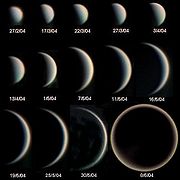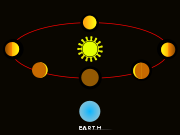
Phases of Venus
Encyclopedia

Planetary phase
Planetary phase is the term used to describe the appearance of the illuminated section of a planet. Like lunar phases, the planetary phase depends on the relative position of the sun, the planet and the observer....
of the planet Venus are the different variations of lighting seen on the planet's surface, similar to lunar phase
Lunar phase
A lunar phase or phase of the moon is the appearance of the illuminated portion of the Moon as seen by an observer, usually on Earth. The lunar phases change cyclically as the Moon orbits the Earth, according to the changing relative positions of the Earth, Moon, and Sun...
s. The first recorded observations of them were telescopic observations by Galileo Galilei
Galileo Galilei
Galileo Galilei , was an Italian physicist, mathematician, astronomer, and philosopher who played a major role in the Scientific Revolution. His achievements include improvements to the telescope and consequent astronomical observations and support for Copernicanism...
in 1610. Although the extreme crescent phase of Venus has been observed with the naked eye
Naked eye
The naked eye is a figure of speech referring to human visual perception unaided by a magnifying or light-collecting optical device, such as a telescope or microscope. Vision corrected to normal acuity using corrective lenses is considered "naked"...
there are no indisputable historical pre-telescopic records of it being observed.
Observation
The Phases of Venus result from the planet's orbitOrbit
In physics, an orbit is the gravitationally curved path of an object around a point in space, for example the orbit of a planet around the center of a star system, such as the Solar System...
around the Sun
Sun
The Sun is the star at the center of the Solar System. It is almost perfectly spherical and consists of hot plasma interwoven with magnetic fields...
inside the Earth
Earth
Earth is the third planet from the Sun, and the densest and fifth-largest of the eight planets in the Solar System. It is also the largest of the Solar System's four terrestrial planets...
's orbit giving the telescopic
Optical telescope
An optical telescope is a telescope which is used to gather and focus light mainly from the visible part of the electromagnetic spectrum for directly viewing a magnified image for making a photograph, or collecting data through electronic image sensors....
observer a sequence of progressive lighting similar in appearance to the moon's phases
Lunar phase
A lunar phase or phase of the moon is the appearance of the illuminated portion of the Moon as seen by an observer, usually on Earth. The lunar phases change cyclically as the Moon orbits the Earth, according to the changing relative positions of the Earth, Moon, and Sun...
. It presents a full
Full moon
Full moon lunar phase that occurs when the Moon is on the opposite side of the Earth from the Sun. More precisely, a full moon occurs when the geocentric apparent longitudes of the Sun and Moon differ by 180 degrees; the Moon is then in opposition with the Sun.Lunar eclipses can only occur at...
image when it is on the opposite side of the Sun. It shows a quarter phase when it is at its maximum elongation from the Sun. Venus presents a thin crescent in telescopic views as it comes around to the near side between the Earth and the Sun and presents its new phase
New moon
In astronomical terminology, the new moon is the lunar phase that occurs when the Moon, in its monthly orbital motion around Earth, lies between Earth and the Sun, and is therefore in conjunction with the Sun as seen from Earth...
when it is between the Earth and the Sun. Since the planet has an atmosphere it can be seen at new in a telescope by the halo of light refracted around the planet. The full cycle from new to full to new again takes 584 days (the time it takes Venus to overtake the Earth in its orbit). The planet also changes in apparent size from 9.9 arc seconds
Minute of arc
A minute of arc, arcminute, or minute of angle , is a unit of angular measurement equal to one sixtieth of one degree. In turn, a second of arc or arcsecond is one sixtieth of one minute of arc....
at full (superior conjunction) up to a maximum of 68 arc seconds at new (inferior conjunction). Venus reaches its greatest brilliancy (magnitude –4.5
Apparent magnitude
The apparent magnitude of a celestial body is a measure of its brightness as seen by an observer on Earth, adjusted to the value it would have in the absence of the atmosphere...
) when it is an intermediate crescent shape at the point in its orbit when it is 68 million kilometers away from the Earth (a combination of its closeness and the fact that it is 28% illuminated).
History

Telescope
A telescope is an instrument that aids in the observation of remote objects by collecting electromagnetic radiation . The first known practical telescopes were invented in the Netherlands at the beginning of the 1600s , using glass lenses...
, Galileo was able to observe Venus going through a full set of phases, something prohibited by the Ptolemaic system (which would never allow Venus to be fully lit from the perspective of the Earth or more than semi-circular). This observation essentially ruled out the Ptolemaic system, and was compatible only with the Copernican system and the Tychonic system
Tychonic system
The Tychonic system was a model of the solar system published by Tycho Brahe in the late 16th century which combined what he saw as the mathematical benefits of the Copernican system with the philosophical and "physical" benefits of the Ptolemaic system...
and other geoheliocentric models such as the Capellan and Riccioli
Giovanni Battista Riccioli
Giovanni Battista Riccioli was an Italian astronomer and a Catholic priest in the Jesuit order...
's extended Capellan model.
Naked eye observations
The extreme crescent phase of Venus can be seen without a telescopeTelescope
A telescope is an instrument that aids in the observation of remote objects by collecting electromagnetic radiation . The first known practical telescopes were invented in the Netherlands at the beginning of the 1600s , using glass lenses...
by those with exceptionally acute eyesight, at the limit of human perception. The angular resolution
Angular resolution
Angular resolution, or spatial resolution, describes the ability of any image-forming device such as an optical or radio telescope, a microscope, a camera, or an eye, to distinguish small details of an object...
of the naked eye is about 1 minute of arc. The apparent disk of Venus' extreme crescent measures between 60.2 and 68 seconds of arc, depending on the distance from Earth. Nevertheless it is possible for observers with extremely acute eyesight to see a crescent Venus under ideal atmospheric circumstances.
There have been numerous reports stating such observations. The phases of Venus are alleged to have been seen in Mesopotamia
Mesopotamia
Mesopotamia is a toponym for the area of the Tigris–Euphrates river system, largely corresponding to modern-day Iraq, northeastern Syria, southeastern Turkey and southwestern Iran.Widely considered to be the cradle of civilization, Bronze Age Mesopotamia included Sumer and the...
n times by priest-astronomers. Ishtar
Ishtar
Ishtar is the Assyrian and Babylonian goddess of fertility, love, war, and sex. She is the counterpart to the Sumerian Inanna and to the cognate north-west Semitic goddess Astarte.-Characteristics:...
(Venus) is described in cuneiform
Cuneiform script
Cuneiform script )) is one of the earliest known forms of written expression. Emerging in Sumer around the 30th century BC, with predecessors reaching into the late 4th millennium , cuneiform writing began as a system of pictographs...
text as having horns. However, other Mesopotamian deities were depicted with horns, so the phrase could have been simply a symbol of divinity.
External links
- Observations and Theories of Planetary Motion
- The crescent Venus seen with the naked eye
- Owen GingerichOwen GingerichDr. Owen Jay Gingerich is a former Research Professor of Astronomy and of the History of Science at Harvard University, and a senior astronomer emeritus at the Smithsonian Astrophysical Observatory...
- Empirical proof and/or persuasion — lecture on Galileo's observation of the phases of Venus from a renowned historian of science - You tube animation of the phases of Venus predicted by the pure geocentric Ptolemaic model http://uk.youtube.com/watch?v=OlnlbZHP-jk
- You Tube animation of the phases of Venus predicted by the heliocentric model (and implicitly also by the geo-heliocentric models such as the Tychonic) http://uk.youtube.com/watch?v=0Z_v7Tag4fg&feature=related

